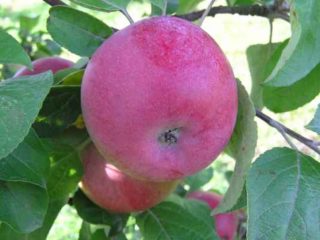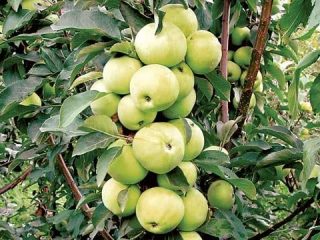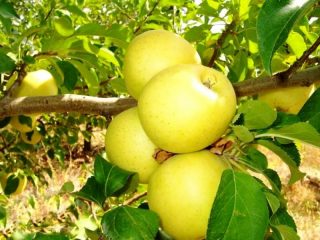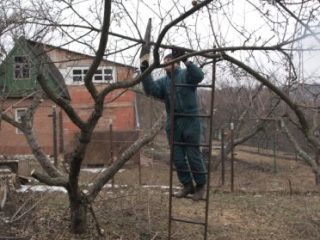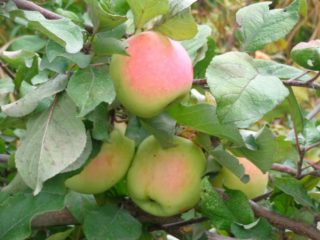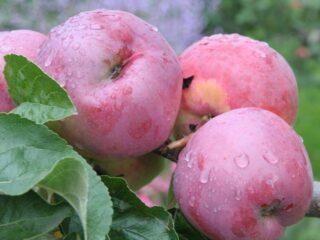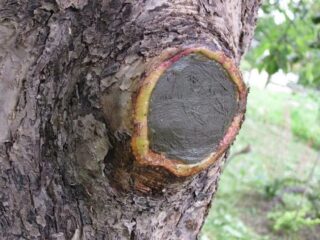Content
Apple tree leaves turn black for various reasons. Most often they are associated with fungal, bacterial or viral diseases. To solve the problem, plantings are treated with fungicides, insecticides or other means. But some diseases are incurable, so all that remains is to cut down the trees.
Why do black spots appear on apple tree leaves?
Often black spots on apple tree leaves are associated with diseases. Some of them can be cured, especially at an early stage. Others cannot be treated, so all that remains is to get rid of the affected tree so as not to infect neighboring plantings.
Bacterial burn
If black dots appear on the leaves of the apple tree, this probably indicates a bacterial burn. The pathology is infectious and very complex because it is practically untreatable.The foliage turns black at different times - in early spring, at the beginning of the flowering phase, or already in autumn.
The spots that appear quickly grow, merge together, after which the leaf becomes completely black and dries out. Moreover, the foliage remains on the tree and no falling is observed. The tree gradually drops its fruits and may die.
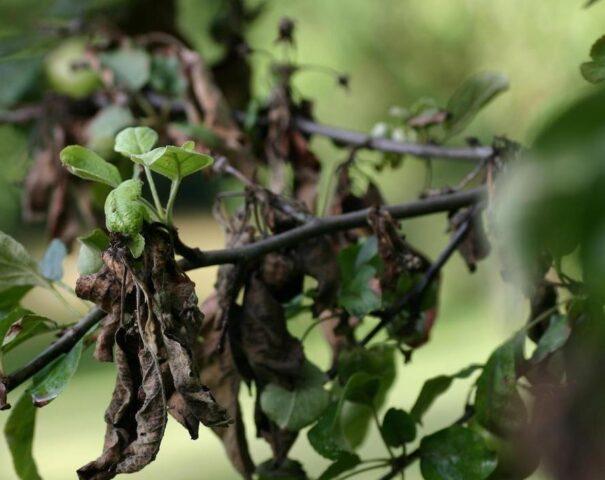
Symptoms of bacterial burn
A characteristic sign is that not only the leaves become black, but also all other parts. From the outside it may seem that the apple tree was on fire or was struck by lightning. That is why the pathology is called a bacterial burn.
Basic treatment measures:
- Completely remove all shoots affected by the disease, including at least 5 cm of the healthy part.
- Treat the sections with a weak solution of potassium permanganate or sprinkle with charcoal powder.
- Treat with a powerful fungicide containing copper. This can be “HOM”, “Oxychom”, “Bordeaux mixture”, “Ordan” and other means.
- After autumn leaf fall, it is necessary to treat the entire tree with a concentrated (50%) urea solution.
Scab
If the leaves of the apple tree not only turn black, but also curl, this indicates the development of a fungal scab disease. First, brown oil spots appear on the foliage. Then they begin to darken, after which the plate curls and dries. Then the leaves fall from the tree, this is the main difference between scab and fire blight.
The affected tree may live for several more years, but it will grow worse, which will also have a bad effect on yield. Therefore, it is recommended to start treatment as early as possible.Plantings are treated with fungicides:
- "Abiga Peak";
- "Bordeaux mixture";
- "Topaz";
- "Skor";
- "Ridomil Gold";
- "Raek."
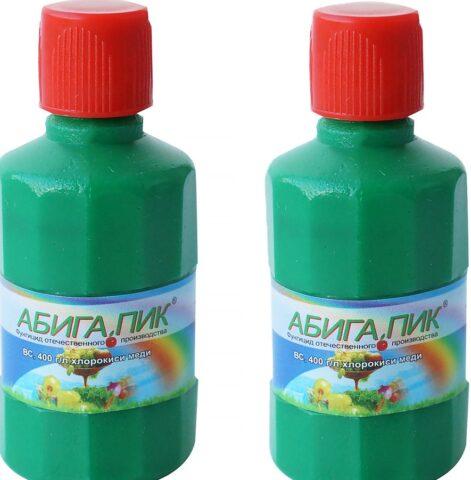
"Abiga-Pik" is one of the best fungicides against scab
Spraying is done several times a season with an interval of two weeks. The last treatment should take place a maximum of 28 days before the fruit begins to appear.
Ring spot
If the leaves are initially covered with yellow spots, the cause is due to ring spot. After some time, the surface of the leaf plate begins to darken and expand. Black spots form on both foliage and fruit - these are necrotic areas in which plant tissues die.
Ring spot is a very dangerous disease of a viral nature. Its consequences are noticeable already in the first season:
- the tree grows poorly, it is weakened;
- shoots look shortened;
- leaf blades become smaller and turn black;
- productivity is falling.
If black spots on the leaves of an apple tree appear due to ring spot, it is difficult to treat the tree; there are no drugs for this disease. Therefore, the affected shoots are completely removed, and the apple tree is treated with agents to stimulate the immune system, for example;
- "Zircon";
- "Epin";
- "Zdravin" and others.
Apple tree leaves turn black at the edges and tips
If the tips of the leaves on an apple tree turn black, this may be due to both diseases and improper care. The main reasons are described below.
Nutrient deficiencies
If the leaves turn black not only along the contour, but also at the tips, one of the possible reasons is a lack of manganese and magnesium compounds. This disease is not infectious in nature; it is called chlorosis. A characteristic sign is paleness of the foliage, loss of rich green color.To compensate for the deficiency, it is recommended to carry out foliar spraying with the following solutions:
- magnesium sulfate (0.03%);
- manganese sulfate (0.05%);
- "Ditan" (20 g per 10 l) is an antifungal drug that contains manganese and zinc.
It is necessary to perform root feeding:
- dolomite flour;
- magnesium nitrate (0.1%).
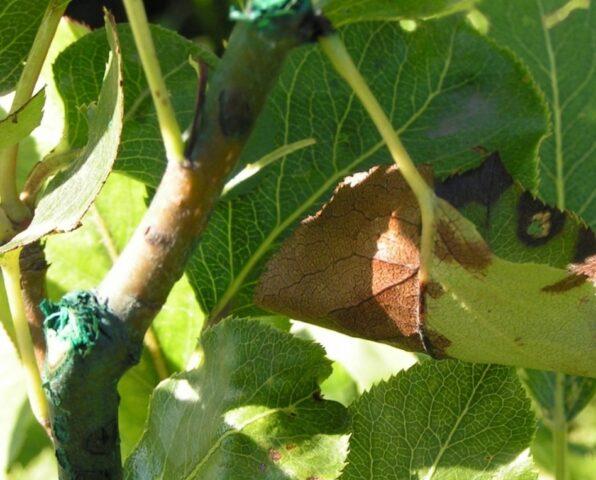
Blackening of the leaves around the edges is associated with a lack of manganese and magnesium
It is better to alternate treatments with an interval of 10-15 days. To completely restore the deficiency, three feedings are enough. It is necessary to monitor the condition of the apple tree - as soon as black leaves stop appearing, stop applying fertilizers. It is important to remember that overfeeding is worse than underfeeding.
Root system burn
If a tree's young leaves turn black, this may be due to root burn. This occurs due to improper care, when apple trees are given fresh, unrotted manure or watered with a urea solution immediately after planting. In such cases, it is recommended to completely replace the surface layer of soil. You need to work carefully so as not to damage the roots of the plant.
Mosaic
Leaves may turn black due to mosaic, a viral infectious disease. First, bright yellow stripes and dots appear on them, after which they begin to turn black and die. Damaged foliage falls off (even in summer). The tree grows noticeably worse, and the yield may drop by half. If the infection starts, fruiting will stop completely.
To prevent planting, it is recommended to treat it with Epin or another immunostimulant.
Why does a black coating appear on the leaves?
If a black coating appears on the foliage of the apple tree, this indicates the development of an infectious disease. The cause may also be associated with dangerous pests - aphids or spider mites.
Black cancer
Black canker refers to fungal pathologies, due to which red or red-brown dots first appear on the foliage. They then merge and form dark spots. If a black coating appears, resembling soot, this indicates an advanced stage of the disease.
The sheet plates are coated not only from the outside, but also from the inside. As a result, they dry out and begin to fall off. Because of this, already in the middle of summer the tree may remain bare.
When the first signs are detected, all affected shoots and other parts should be pruned and removed. Healthy fragments are treated with copper-containing preparations:
- "Bordeaux mixture";
- "Oxychom";
- “Copper sulfate” and others.
The sections are lubricated with garden varnish, to which it is better to add “Fitosporin” or other fungicides. Treatments should be carried out repeatedly, for example, 2-3 times with an interval of three weeks.
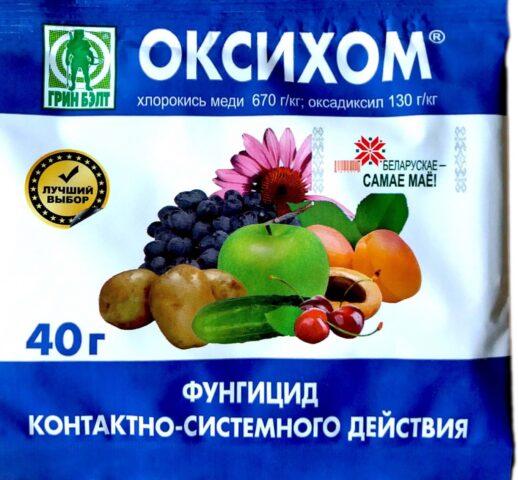
"Oxychom" - a powerful fungicide against black cancer
Sooty coating
A thick, black, sooty coating can be caused by pests such as spider mites or aphids. Insecticides help cope well with them:
- "Inta-Vir";
- "Decis";
- "Aktara";
- "Fitoverm";
- "Aktellik" and others.
You can also prepare a copper-soap solution. To do this, dilute 5 g of copper sulfate and 150 ml of liquid soap in 10 liters of water (instead, you can use grated laundry soap).
Blackening of leaves on an apple tree after treatment
If the leaves on an apple tree turn black and curl after treatment with a fungicide or other drug, the reason may be due to a high concentration of the drug or an incorrect choice of treatment period.
A high content of active substance is especially dangerous in the case of copper-containing products. Therefore, when preparing the solution, you need to carefully read the instructions. The dosage should not be violated even to a small extent, especially if spraying is carried out in hot weather.
What to do if the leaves on young apple trees turn black
If the leaves turn black on young seedlings, the reason may be due to insufficient watering. Normally, apple trees are given water several times a season. But young seedlings should be watered at least once a week. If there is a drought, water is given at least twice a week.
When watering, you can add “Zircon” or “Epin” to the bucket. Excess moisture is also harmful. Therefore, it is necessary to monitor the condition of the soil. The surface layer should remain only slightly damp.
Sometimes the leaves of young apple trees turn black because they have been infected with a bacterial, fungal or viral disease. This is often observed in cases where seedlings were purchased from dubious sellers. Therefore, it is better to plan your purchase from a nursery or other responsible suppliers.
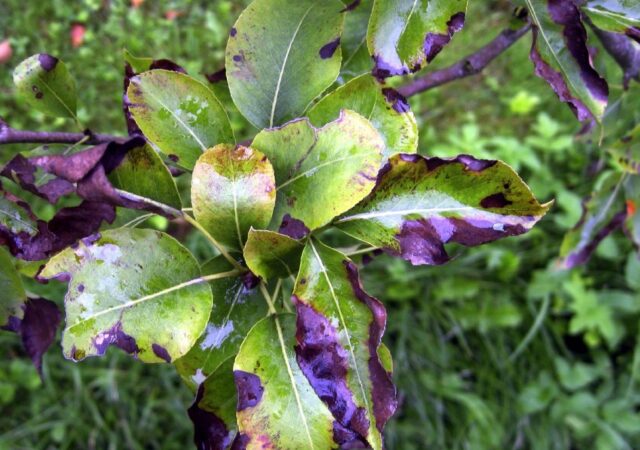
Blackened leaves on young apple trees may appear due to insufficient watering.
Prevention measures
To prevent apple tree diseases and other reasons that cause leaves to turn black, you must adhere to certain rules. This is important at all stages - from purchasing a seedling to caring for an adult tree. The main preventive measures come down to regular fertilizing, moderate watering, regular treatments and pruning.
Choosing the right seedling
To prevent the leaves from turning black, it is best to purchase apple tree seedlings from nurseries or other reputable stores. When purchasing a plant, you need to inspect it. All shoots and leaves must be healthy, without spots, spots or other extraneous signs. If possible, the root system should also be inspected.
Cleanliness in the garden
Periodically it is necessary to inspect the tree trunk circles and do weeding. You should also remove mosses and lichens that settle on trunks, branches and parasitize trees. In autumn, after pruning and leaf fall, all plant debris is carefully removed and burned. The soil in the root zone is dug up, and at the same time the trunk can be whitened. Moreover, it is advisable to repeat this procedure in early spring.
Trimming
To prevent apple tree leaves from turning black, timely pruning should be carried out. In early spring, remove dry, weakened and dried out branches. In autumn you can do formative pruning. The sections are treated with garden varnish, a fungicide solution, or sprinkled with charcoal powder.
Top dressing
To prevent the leaves from turning black, regular feeding should be done. In the spring, the tree trunk circle is dug up and humus or compost is added there.During the period of fruit formation, superphosphate and potassium are given. In autumn, a complex fertilizer is applied, for example, “Kemira autumn”.
Preventative treatments

To prevent apple tree leaves from turning black due to diseases or pests, it is recommended to carry out preventive treatments with special preparations
This should be done at different stages. Schemes depend on the choice of a specific tool.
For example, spraying with Bordeaux mixture is carried out in this mode:
- early spring - 3% solution;
- after bud break – 1%;
- after harvesting – 1%.
To prevent the appearance of black leaves, apple trees can be sprayed with iron sulfate:
- early spring - 5% solution;
- after bud break and after flowering ends – 1%.
Copper sulfate treatment schedule:
- in March-April – 3% solution;
- after bud break – 1%;
- at the end of flowering - 1%.
Conclusion
The leaves of the apple tree turn black due to infectious diseases. The most dangerous are viral and bacterial, since it is often impossible to destroy pests. Therefore, it is recommended to follow basic preventive measures and periodically inspect the plantings. If black plaque or spots are detected, you need to determine the cause and begin treatment immediately.
